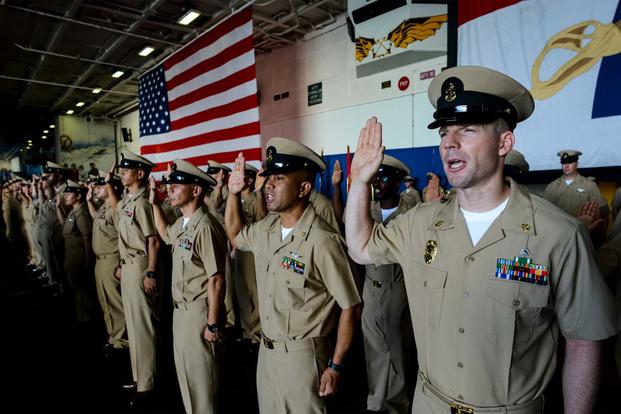The Navy has too many chiefs in shore-based jobs, so it's shipping more than a thousand of its senior enlisted sailors to sea and to operational units in a significant personnel shake-up.
Navy leaders announced Monday that a new policy will move sailors in the ranks of chief, senior chief, and master chief petty officer from overmanned shore-based ratings to leaner operational units over the next several months.
Related content:
- Career Sea Pay
- Removed Sub Commander Faces Adultery, Conduct Unbecoming Charges
- Navy Offers $2,500 Reward for Info on Phony Bomb Threats
"Our number one priority is to keep the Fleet properly manned," Chief of Naval Personnel Vice Adm. Robert Burke said in a statement. "We are aggressively using all force shaping levels to do just that."
In all, 25 ratings are overmanned with senior enlisted sailors, officials with the Office of the Chief of Naval Personnel said.
These include the following:
- Fire Controlman
- Cryptologic Technician, Collection
- Machinist's Mate (Surface Warfare)
- Yeoman
- Aviation Electrician's Mate
- Aviation Electronics Technician
- Aviation Machinist's Mate
- Hospital Corpsman
- Aviation Structural Mechanics
- Electronics Technician (Surface Warfare)
- Boatswain's Mate
- Gunner's Mate
- Naval Air Crewman Operator
- Personnel Specialist
- Quartermaster
- Electrician's Mate Nuclear (Surface Warfare)
- Electronics Technician Nuclear Power
- Information Systems Technician, Submarines
- Logistics Specialist (Subsurface)
- Yeoman (Subsurface)
- Machinist's Mate Nuclear
- Culinary Specialist (Subsurface)
- Utilitiesman
- Cryptologic Technician Interpretive (Eastern Europe)
- Cryptologic Technician Interpretive (Latin/South America)
Within these ratings, the Navy expects more than 1,100 senior sailors may be moved to operational units.
The overmanning, officials said, has largely resulted from "strict adherence" to rules governing sea-shore-flow and sea-shore rotation, or the ratio of time a sailor spends stateside versus deployed.
Within the ratings, chiefs eligible for reassignment under the new policy include those assigned to an unfunded billet, assigned in excess of authorized supervisor billets, or filling a billet with a lower paygrade.
For newly minted chiefs, initial assignment to sea and operational billets will be considered the new normal, according to a Navy administrative message also published Monday.
"The revised rules will more closely resemble officer career paths, which respect the need for rotation ashore, but also recognize the critical need for leaders at sea," officials said in a release.
Those who are at risk for involuntary reassignment should consider participating in the Navy's Voluntary Sea Duty or Sea Duty Incentive Pay programs, officials said in the message.
All enlisted supervisors will have their assignments reviewed to ensure they're in keeping with the plan to improve manning across the fleet. Rather than considering rotational and sea-shore-flow requirements first when matching senior enlisted sailors to new postings, detailers will make fleet manning requirements the first consideration, officials said.
Rotational and sea-shore-flow concerns will still be taken into account as secondary factors, as will recent deployment dates and dwell time, career progression, manning posture, and critical Navy enlisted classification codes at relevant commands, according to the message.
"Chiefs are the Navy's critical leadership element," Burke said in a statement. "This [policy] change places chief petty officers into a 'career path' [versus] 'sea-shore-flow' paradigm, much like that for officers.
"It is essential that we have our deck-plate leaders, including newly selected chiefs, where it counts -- on ships and submarines, in aviation squadrons, and in other operational or fleet production units on the leading edge of our combat teams," he said.
-- Hope Hodge Seck can be reached at hope.seck@military.com. Follow her on Twitter at @HopeSeck.































